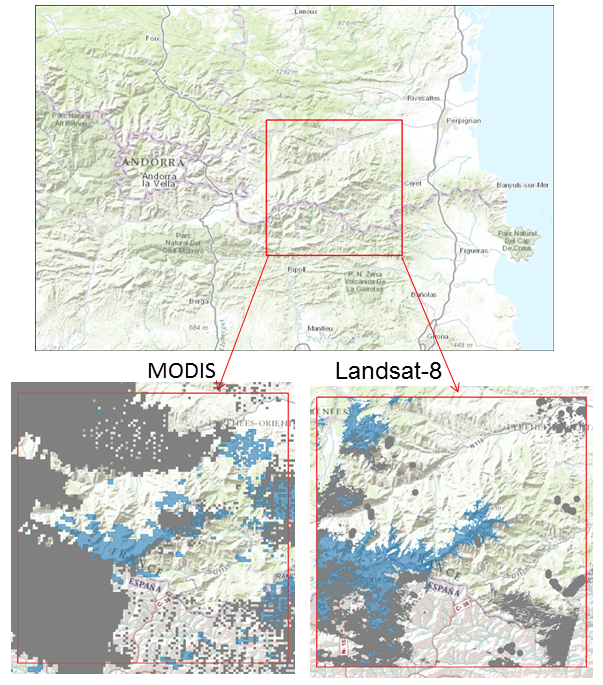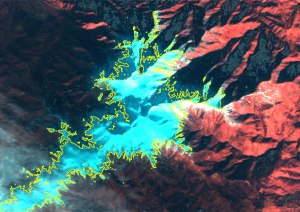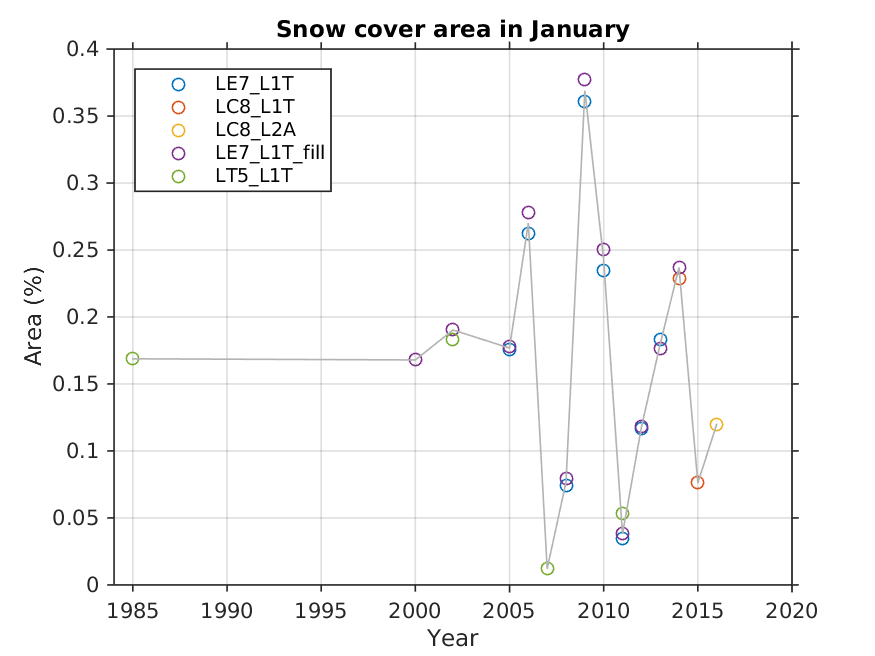In a lecture given at University Paul Sabatier on December 10, 2015 « Should we be afraid of climate change? », Franck Roux told this sentence (I quote from memory):
« The human being is a very good weather sensor, but it is a poor climate sensor. »
Since our memory can play tricks on us, satellite images are valuable data. As we have seen in a previous article, the snow cover area in the Pyrenees was rather small in January 2016. We can reconstruct the snow extent across the whole mountain range since 2000 with MODIS or even 1998 with SPOT-VGT. However if you want to zoom in on a specific region, the spatial resolution offered by these sensors quickly becomes insufficient so we must turn to the Landsat archive.

Landsat-5 worked 29 years since 1984, Landsat 7 was launched in 1999 but since 2003 the data are degraded due to a failure of the sensor. Since 2013, Landsat-8 took over. An issue with the Landsat archive is that the frequency of the observations is low. Furthermore the Landsat-5 series is not continuous. Orthorectified Landsat images from the USGS (L1T level) are available in the Google Earth Engine, which enables to quickly extract the complete series of images available in the Canigou area since 1985. For 2016, we kept the L2A product which was used to make the map above.


These images were not corrected for atmospheric effects or slope effects therefore the detection of the snow covered surface is much less reliable than with L2A products from THEIA . However, using a simple threshold on the NDSI and the red band one can extract a decent snow mask to compare the snow cover area for all these years. To solve the problem of the data gaps in Landsat-7 images, one can calculate the snow cover fraction on the part of the image without gaps and just make the assumption that this represents correctly the fraction over the full image. Another option is to fill the gaps from neighboring pixels. Here we applied gdal_fillnodata.py, which uses an inverse distance weighting interpolation algorithm, but there are more sophisticated methods.

We note a good agreement between the areas computed from Landsat 5 and 7 when the comparison is possible (in 2002 and 2011). Similarly, the gap-filling of Landsat-7 images does not change much the snow cover fraction. Or rather, the differences are much smaller than the inter-annual differences. Finally, we see that the Canigou has probably experienced some less snowy winters … We shall not over-interpret this time series because each image is not necessarily representative of the entire month of January. A clear-sky acquisition can take place a few days before a snowfall. Yet, the high variability of snow cover area on this mountain is striking. It reflects the influence of the Mediterranean climate on the eastern Pyrenees.
Nota Bene: The Canigou inspired the beautiful poem « Canigó » by Catalan poet Jacint Verdaguer i Santaló (English translation from Wikipedia):
The Canigó is an immense magnoliathat blooms in an offshoot of the Pyrenees; its bees are the fairies that surround it, and its butterflies the swans and the eagles. Its cup are jagged mountain chains, colored in silver by the winter and in gold by the summer, huge cup where the star drinks fragrances, the airs freshness and the clouds water. The pine forests are its hedges and the ponds its dew drops, and its pistil is that golden palace, seen by the nymph in her dreams descending from heaven.
